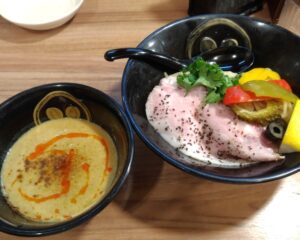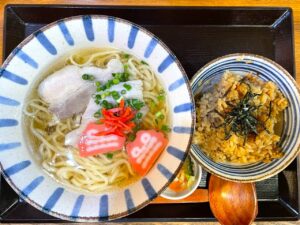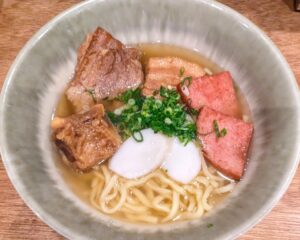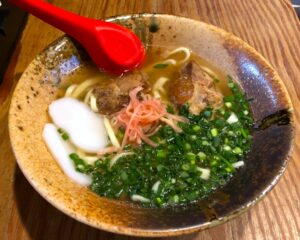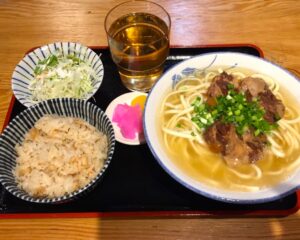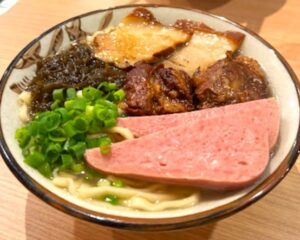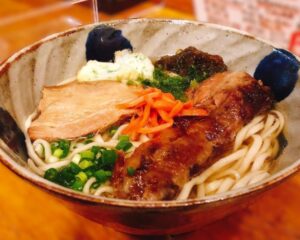Okinawa Soba / Okinawa Ramen (Okinawa Pref.)
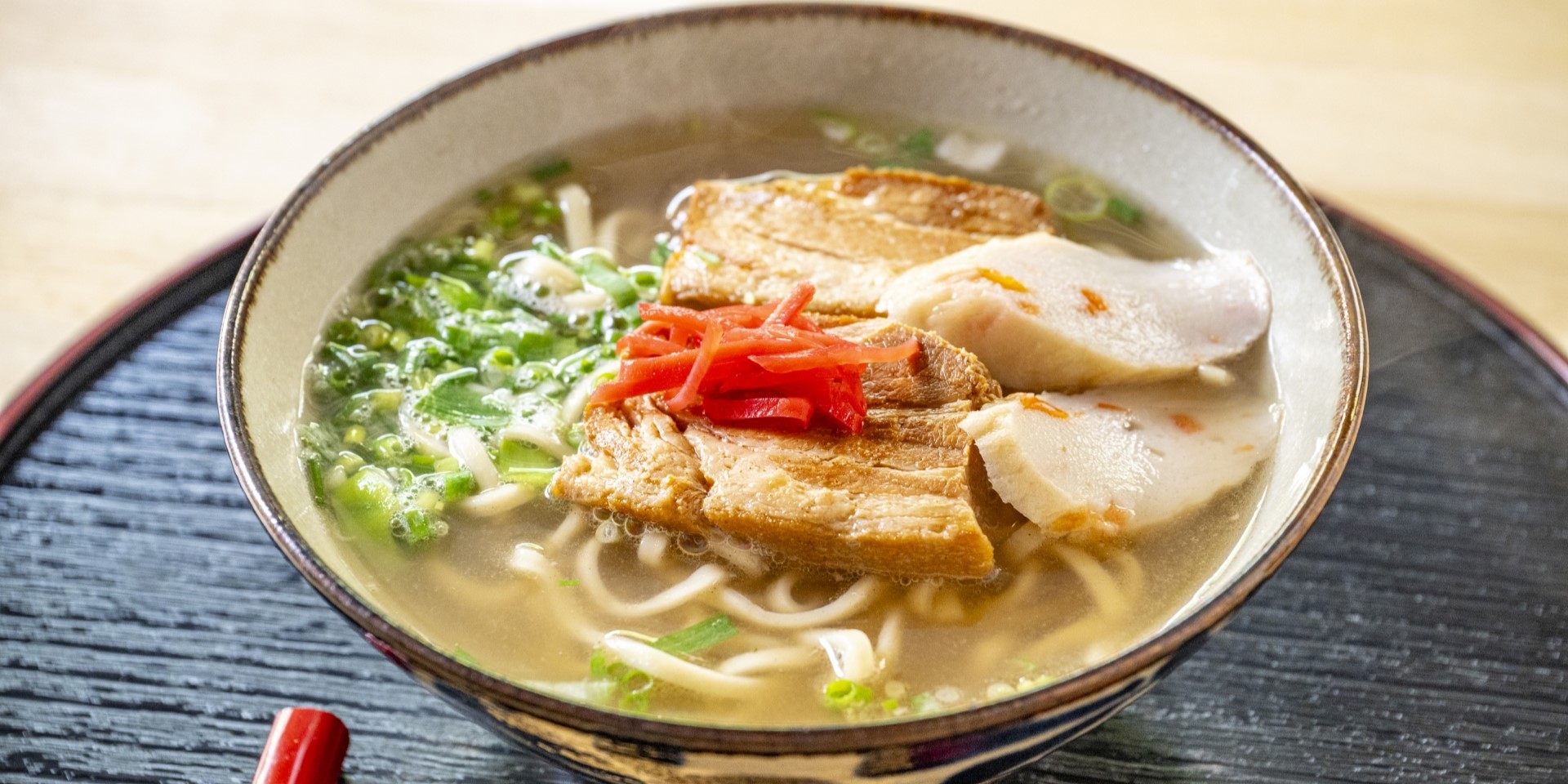
What is Okinawa Soba(沖縄そば)?
Although it is written as “soba(そば),” it does not use buckwheat flour and refers to noodles in general. Like ramen noodles, “Okinawa Soba(沖縄そば)” is made by kneading wheat flour with KANSUI (かんすい Alkaline salt solution,Brine water). Until the 1950s, kansui was not used, and it was made using the alkaline supernatant liquid of wood ash (木灰 Mokuhai/Mokuhai/Kibai) soaked in water from burning banyan trees and other trees.
If ramen is defined as “noodles made with kansui,” then Okinawa Soba is ramen, but it is also a unique genre of Okinawa soba in that it is covered in oil and retains its own unique manufacturing method.
In Okinawa Prefecture, it was called Shina Soba(支那そば) in the 1900s, but now it is simply called “Soba(そば)” or “Suba(すば)” or “Uchina-suba(うちなーすば)” in the local dialect, and soba made with buckwheat flour is distinguished from “Nihon Soba(日本蕎麦)” and “Yamato no Soba(ヤマトのそば).” The texture is said to be closer to udon than ramen.
Depending on the region and shop, the shape of the noodles can be roughly divided into “thick flat noodles,” “medium-thick curly noodles,” “thin flat noodles,” and “thin straight noodles.” They are characterized by their chewy texture, but many are softer.
The main difference between ramen noodles and udon noodles is that after boiling, they are cooled naturally without being rinsed in cold water, and are covered in oil to improve their shelf life, which is then absorbed by the noodles. Noodles covered in oil are called “boiled noodles(茹で麺;Yudemen).” Some shops offer both “fresh noodles(生麺 Namamen)” that is not covered in oil, and boiled noodles that is coverd in oil.
The soup is basically based on pork bones and bonito flakes. A clear salt soup is the mainstream.
The main ingredients are pork belly stewed in sugar and soy sauce, red pickled ginger, kamaboko fish cake, and island onions (scallions that are thinner and have more green parts than long leeks).
There are also many places that serve Hoochibar(フーチバー; Mugwort).
A chili sauce unique to Okinawa called “Ko-re-gu-su(コーレーグース),” made by soaking island chili peppers in Okinawan distilled liquor “Awamori(泡盛),” is served on the table. In addition to Shichimi pepper, some places also serve the sweetly scented island pepper “Pipa-chi(ピパーチ)” (also known as Hihatsumodoki ヒハツモドキ, Hihachi ヒハチ, Pipasu ピパーツ, etc.).
A common side dish, “Juushii(じゅーしー),” is Okinawa-style rice cooked in soba boiling water.
Okinawa soba is often sold as a product group in cafeterias other than specialty shops.
Ramen-Japan / Examples of Ramen Shops
Examples of long-established shops serving Okinawa Soba
-

Kishimoto Shokudo (きしもと食堂/established in 1905) *Uses wood ash. Clear and refined broth.
-
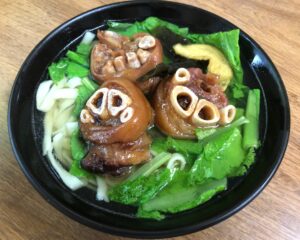
-
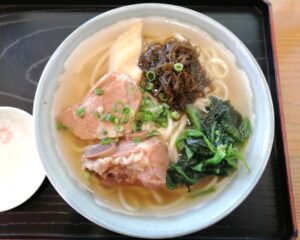
Koja Sobaya (古謝そば屋/1932) *Traditional Miyako soba. Uses porl red meat.
-
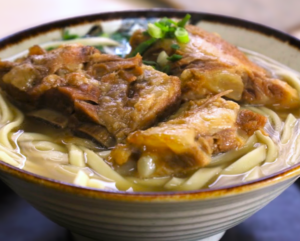
Marutaka Soba (丸隆そば/1948) *A shop that claims to serve the original soki soba.
-
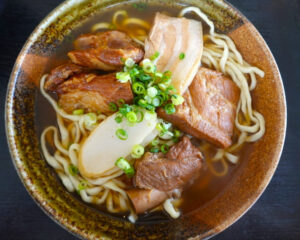
-
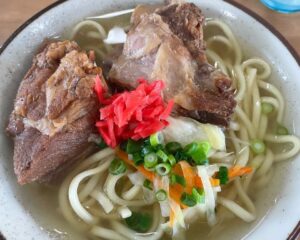
-
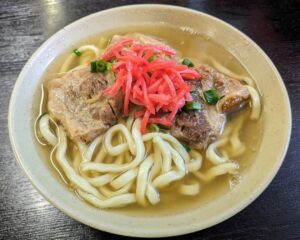
-
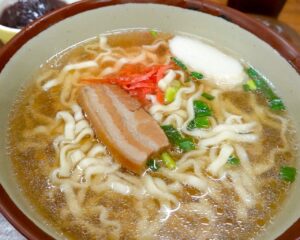
-
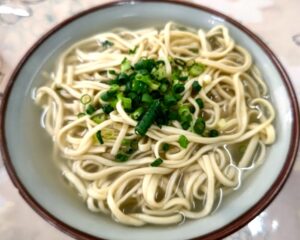
-
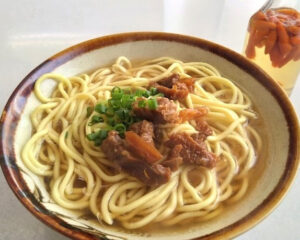
Nakayoshi Shokudo (なかよし食堂/1969) *Serves Yaeyama soba with pork clear soup.
-
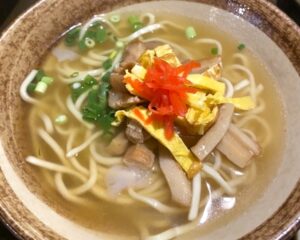
-
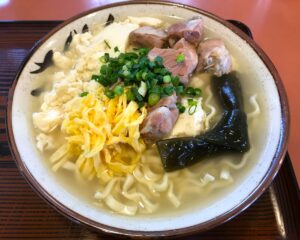
-
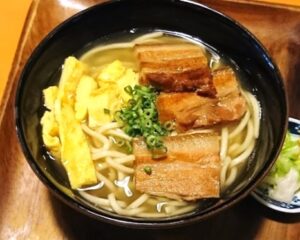
-
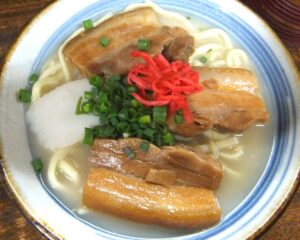
Mutsumibashi Kadoya (むつみ橋かどや/1972) *A small, long-established Okinawa soba shop in a tourist area.
-
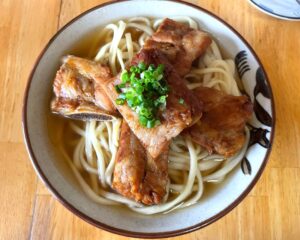
Yanbaru Soba (山原そば/1973) Large servings of meat. Strong bonito broth. Soft noodles.
Okinawa Soba / Soki Soba / Okinawa Ramen
Soki(ソーキ) means “pork spare ribs,” and this dish uses them. Other dishes that use Okinawan ingredients include “Tebichi Soba” using “Tebichi (てびち Pig’s feet),”
“Nakami Soba(中味そば)” using “pork innard(豚モツ),” and “Yushi dofu Soba(ゆし豆腐そば)” using local tofu. These are collectively called “Okinawa Soba(沖縄そば).” There are two theories about the origin of Soki Soba: “Marutaka Soba(丸隆そば)” and “Gabusoka Shokudo(我部祖河食堂).”
“Okinawa Ramen(沖縄ラーメン)” was created in 2000 when Kawahara Narumi(河原成美), founder of Hakata Ippudo(博多一風堂), planned to develop “Okinawa Ramen” as part of the “New Local Ramen Creation Plan” of the Shin-Yokohama Ramen Museum. (pork bone soy sauce soup/thick noodles) It has a short history and common characteristics have not yet been established.
Okinawa Prefectural Products Corporation sometimes sells instant ramen using Okinawa’s salt as “Okinawa Ramen”. In addition, a ramen made with pork bone and seafood broth seasoned with salt from Okinawa and topped with cartilage pork ribs was entered into the “Local Ramen Grand Prix 2013” as Okinawa local ramen, but a definition has not been established.
Examples of popular Okinawa Soba shops
-
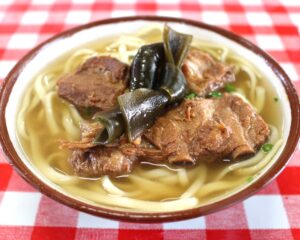
-
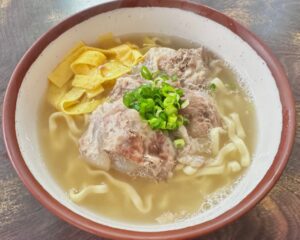
-
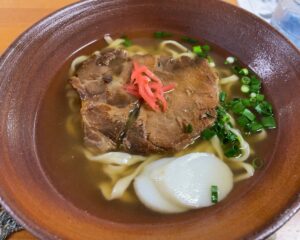
Ten to Ten (てんtoてん/1997) *Hand-made noodles made with traditional wood ash. Covered in green ivy.
-
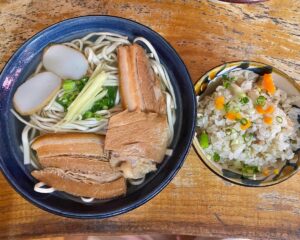
Shuri Soba(首里そば/1994) *Hard to find as it is a traditional house. Popular so it sells out quickly.
-
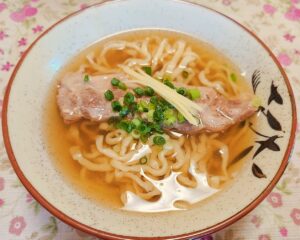
Niima Soba(にいまそば) *Homemade chewy, curly noodles. The soup has a strong bonito flavor.
-
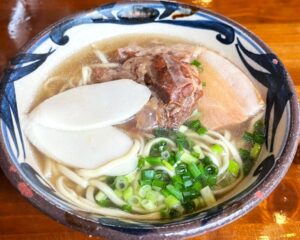
-

Nakamura Soba(なかむらそば) *Green homemade noodles made with Aasa (green laver).
-
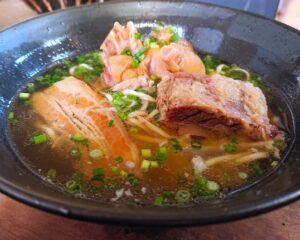
Sumanumee(すーまぬめぇ) *Okinawa folk house, terrace seating available. Means “in front of Shioma home”.
-
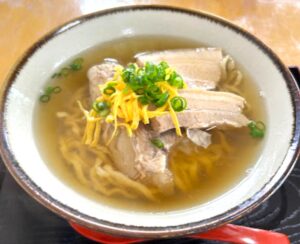
Okinawa Soba Marukami(まるかみ) *Popular shop opened by a French chef. Refill system available.
-
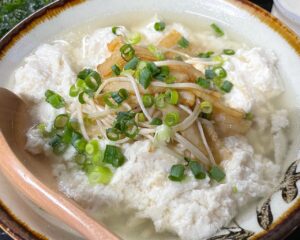
Tofu no Higa *Famous for yushi tofu. Popular from the morning.
-
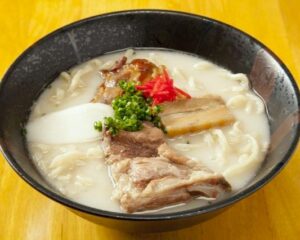
-
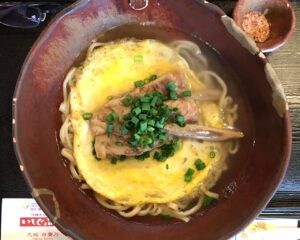
-

-
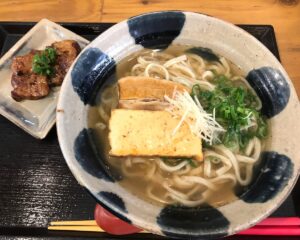
-
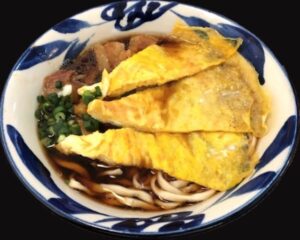
Miyoya(みよ家) *Also serves the original Okinawa soba “Toujin Soba” and the second “Beelaa Soba.”
Okinawa soba, which has a longer history than ramen, and the influx of ramen culture from the mainland Japan
When it comes to noodle culture in Okinawa, one of the Okinawan dishes is “Okinawa soba”. Its origins date back to the opening of Okinawa’s first restaurant, “Kankairo(観海楼),” in 1902, so it has a longer history than ramen.
There are records that it was served as a royal dish in the Ryukyu Kingdom (琉球王国 1429-1879) before it was incorporated into Japan 450-500 years ago. It is said that Chinese noodle culture was introduced to the Ryukyu Kingdom during trade between the two countries. The use of wood ash to make noodles is said to have originated in Meixian, Guangdong Province(広東省梅県), China and in Taiwan, the Hakka(客家) ethnic group, and is considered to be the root of Okinawa Soba.
It spread to the wealthy people during the Meiji period (1868-1912), and to the common people from the Taisho period to the postwar period (around 1912-1950), and various Okinawa soba were created.
In the early 1900s, Okinawa soba soup was black, using a lot of soy sauce, as at Kankairo(観海楼), but in 1924, Yutakaya(ゆたか屋) began using red pickled ginger, and developed a salty white soup instead of the black soy sauce-flavored soup, which became popular and became the mainstream at Okinawa soba shops thereafter.
Ushinma Soba(ウシンマーそば), a shop run by a woman, has become popular by beautifully presenting its toppings, which previously consisted only of shredded pork and spring onions, with kamaboko and red pickled ginger, and garnish with island pepper pipachi. This became the origin of the current style of Okinawa soba.
Okinawa soba was the mainstream noodle culture in Okinawa until around 2000.
The thing that changed that was Ryukyu Shinmen Tondou(琉球新麺通堂). Produced by Ippudo’s owner, Narumi Kawahara(河原成美), in 2001, it opened a shop at the Shin-Yokohama Ramen Museum, and in 2002 it returned to Okinawa in triumph and became popular. It had a pork bone soy sauce soup that combined Okinawa soba and Kyushu ramen, and used thick noodles.
The Yokohama Iekey style Musashi-ya(武蔵家), which opened around the same time, also contributed to the spread of Okinawa ramen. (The Musashi-ya in Kichijoji, Tokyo is run by his brother.) Other shops in the same chain in Okinawa are also popular.
There is also a rush to open shops by people originally from Tokyo ramen shops.
“Menya Guu(麺や偶)” from “Toride(砦)” serves Tokyo-style tonkotsu ramen using homemade extra-thin noodles.
“Sanchikuju(三竹寿)” from Rokurinsha(六厘舎) is a tsukemen specialty shop that has long lines. They also use homemade noodles.
In 2018, “Tojin Soba(唐人そば)”, a reproduction of Kankairo(観海楼)’s first Okinawa Soba, began selling in several shops in the prefecture, and there is also a return to the original Okinawa Soba. Okinawa soba, a part of Okinawan noodle culture, has been transformed into ramen through the creation of local ramen since 2000, and the influx of ramen from other regions has fused together to create a new ramen culture in Okinawa.
Examples of popular ramen shops in Okinawa
-
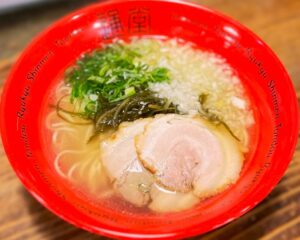
-
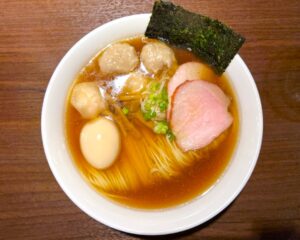
-
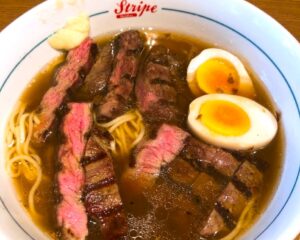
Stripe Noodles(ストライプヌードルズ) *Supervised by Soranoiro(ソラノイロ). Famous for their steak ramen.
-
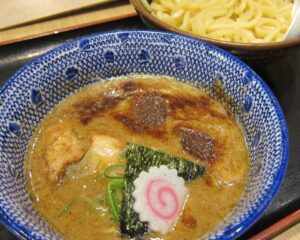
Sanchikuju Main Shop(三竹寿 本店) *Originated from Rokurinsha(六厘舎). Sweet dipping sauce.
-
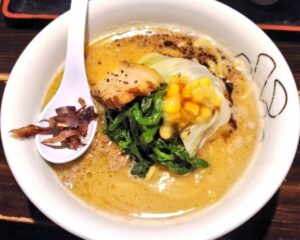
Garyuya(我流家) *Popular local shop. Famous for their tsukemen.
-

-
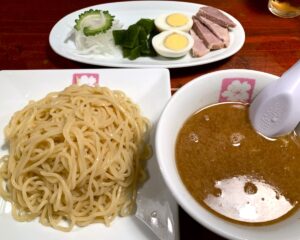
-
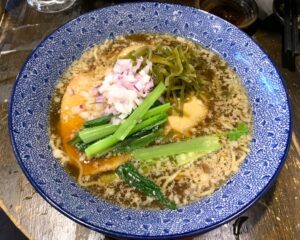
-
